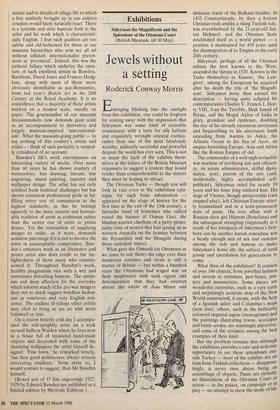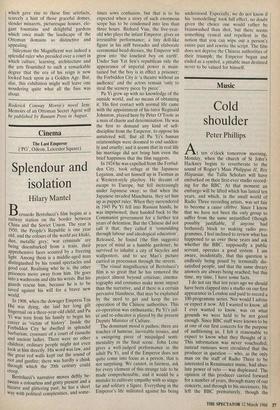Exhibitions
Sfileyman the Magnificent and the Splendour of the Ottoman Court (British Museum, till 30 May)
Jewels without a setting
Roderick Conway Morris
Emerging blinking into the sunlight from this exhibition, one could be forgiven fOr coming away with the impression that &Heyman was some kind of eccentric connoisseur with a taste for silk kaftans and exquisitely wrought oriental exotica, rather than one of the most fabulously wealthy, militarily successful and powerful despots the world has ever seen. This is not so much the fault of the exhibits them- selves as the failure of the British Museum organisers to suggest a context that would render them comprehensible to the visitors they must be hoping to attract.
The Ottoman Turks — though you will look in vain even in the exhibition cata- logue for such basic information — appeared on the stage of history for the first time at the end of the 13th century, a farouche band of horsemen who rallied round the banner of Osman Gazi, the Muslim warrior chieftain of a petty princi- pality (one of several that had sprung up in western Anatolia on the frontier between the Byzantines and the Mongols during those turbulent times).
What gave the Osmanli (or Ottomans as we came to call them) the edge over their numerous enemies and rivals is still a matter of debate — but within a hundred years the Ottomans had waged war on their neighbours with such vigour and determination that they had overrun almost the whole of Asia Minor and immense tracts of the Balkans besides. In 1451 Constantinople, by then a forlorn Christian rock amidst a rising Turkish tide, was overwhelmed by the 21-year-old Sul- tan Mehmed, and the Ottoman State established itself as a world power — a position it maintained for 450 years until the disintegration of its Empire in the early 20th century.
&Heyman, perhaps of all the Ottoman sultans the best known to the West, ascended the throne in 1520. Known to the Turks themselves as Kanuni, 'the Law- giver', among the Europeans he acquired after his death the title of 'the Magnifi- cent'. &Heyman more than earned the description — having quite eclipsed his contemporaries Charles V, Francis I, Hen- ry VIII, Ivan the Terrible, Shah Ismail of Persia, and the Mogul Akbar of India in glory, grandeur and opulence, doubling the size of his already enormous territories and bequeathing to his successors lands extending from Austria to Aden, the Atlantic Ocean to the Sea of Azov, an empire bestriding Europe, Asia and Africa like the Roman Empire of old.
The commander of a well-nigh invincible war machine of terrifying size and efficien- cy, an astute administrator, skilful diplo- matist, poet, patron of the arts (and, incidentally, highly accomplished self- publicist), Shleyman ruled for nearly 50 years and his fame long outlived him. His siege of Vienna, though unsuccessful (rain stopped play), left Christian Europe utter- ly traumatised and in a semi-permanent state of panic. His love affair with a Russian slave girl Hiirrein (Roxelana) and the subsequent strangling (supposedly as a result of her intrigues) of Siileyman's first- born son by another harem concubine was a heady enough mix of sex and violence among the rich and famous to make &Heyman's home life the subject of lurid gossip and speculation for generations to come.
What then of the exhibition? It consists of over 160 objects, from jewelled helmets and swords to costumes, pen-boxes, pot- tery and manuscripts. Some pieces are wonderful curiosities, such as a very early and surprisingly accurate map of the New World constructed, it seems, with the help of a Spanish sailor and Columbus's maps (now lost); others, such as the brilliantly coloured imperial tugras (monograms) and the paintings illustrating towns, seascapes and battle scenes, are stunningly attractive; and some of the ceramics among the best examples of their kind. But the problem remains that although the exhibition provides a rare and welcome opportunity to see these splendours out- side Turkey — most of the exhibits are 011 loan from Turkish collections — disappoin- tingly, it never rises above being an assemblage of objects. There are virtually no ilhistrations of the Ottoman Court in action — in the palace, on campaign or at play — no attempt to show the mode of life which gave rise to these fine artefacts, scarcely a hint of those graceful domes, slender minarets, picturesque houses, ele- gant fountains and delightful gardens which once made the landscape of the Ottoman domains so distinctive and appealing.
%Heyman the Magnificent was indeed a splendid ruler who presided over a court in which culture, learning, architecture and the arts flourished to such a remarkable degree that the era of his reign is now looked back upon as a Golden Age. But, alas, this exhibition might well leave one wondering quite what all the fuss was about.
Roderick Conway Morris's novel Jem: Memoirs of an Ottoman Secret Agent will be published by Bantam Press in August.



















































 Previous page
Previous page